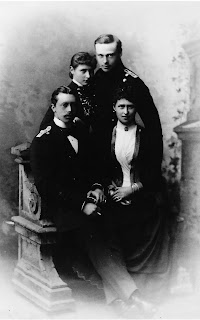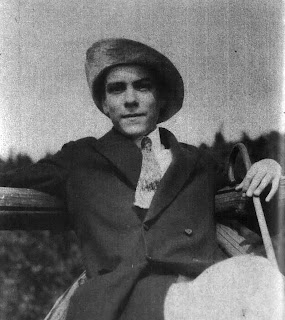Ce soir (16-17 juillet) nous commémorons le centenaire fatidique du martyre de la famille impériale russe.
Dans la soirée du 16 au 17 juillet 1918, le tsar Nicolas II, l'impératrice Alexandra Feodorovna, la grande-duchesse Olga Nikolaïevna, la grande-duchesse Tatiana Nikolaïevna, la grande-duchesse Marie Nikolaïevna, la grande-duchesse Anastasia Nikolaïevna et le tsarévitch Alexeï Nikolaïevitch, accompagnés de quatre fidèles serviteurs, furent assassinés par Yakov Yurovski et sa bande dans le sous-sol de la maison Ipatiev à Ekaterinbourg, la ville la plus bolchevique de la Russie post-tsariste.
La famille impériale fut assignée à résidence sous diverses formes pendant près de 17 mois, à compter de l'abdication du tsar Nicolas II. Cet emprisonnement les conduisit du palais d'Alexandre à Tsarskoïe Selo à la résidence du gouverneur à Tobolsk, pour finir dans la lugubre prison qu'est devenue la maison Ipatiev.
Parfois, la famille impériale était traitée avec respect et déférence. Les contacts avec le monde extérieur étaient sporadiques. Les visiteurs étaient rares et dispersés. Les membres de l’ancienne dynastie régnante étaient tenus à distance. Certains messages parvenaient à leur parvenir, d’autres parvenaient à leur répondre. Le tsar et son entourage vécurent près de 17 mois de difficultés. Ils arrivèrent à Tobolsk avec une suite de près de 40 personnes. Au moment où Iourovski scella leur sort, il ne restait plus que quatre serviteurs fidèles. Ils allaient également mourir en martyrs dans ce petit sous-sol d’Ekaterinbourg.
Le tsar Nicolas et dix autres victimes ont connu une fin atroce aux mains de leurs geôliers. Des déluges de balles s'abattaient par vagues meurtrières. La fumée emplissait la pièce. L'odeur de la poudre à canon, du sang et de la chair... la présence de la mort était accablante. Ceux qui n'étaient pas tués par les balles étaient poignardés et frappés à coups de crosse. C'était une frénésie de brutalité, le point culminant vicieux d'un acte odieux.
Les corps ont été jetés plus tard dans la matinée. Leur localisation est restée inconnue pendant plus de six décennies. Lorsqu'ils ont finalement été retrouvés, le lieu a été gardé secret par crainte de représailles soviétiques.
In death, Tsar Nicholas II and his legacy were vilified, as was the entire tsarist period. Was he an effective ruler? That is a question over which entire books have been written. As a political leader, Nicholas II left much to be desired. yet, he was a product of his environment. As a husband, although loving, devoted, and loyal, he allowed his love for his wife to cloud his better judgement. As a father, Nicholas II seems to have excelled. His children were devoted to him, just as he was devoted to them. As Head of House Russia, Nicholas II failed. Many have criticized other Romanovs for seeking to save themselves from the revolutionary tsunami that engulfed Mother Russia. Yet, as Head of House, Nicholas II forgot that he was responsible for the survival of his dynasty. He isolated himself from other Romanovs. He caused an unbridgeable rift within the dynasty. He ignored their warnings. He led the Romanovs into an abyss of death, poverty and exile.
And yet, Nicholas II did not deserve to die in the manner that Yurovsky and his minions secured his horrific ending. His wife, their children, and those four loyal servants, did not deserve to meet the death that was reserved for them.
Let us not forget as we observe this dreadful centennial that many other members of the dynasty met equally harrowing deaths.
The night after the murders in Yekaterinburg, six other Romanovs met a brutal end in a forest outside there town of Alapaievsk. This second group of martyrs included: Grand Duchess Elisabeth Feodorovna, Grand Duke Sergei Mikhailovich, Prince Ioann Konstantinovich, Prince Konstantin Konstantinovich, Prince Igor Konstantinovich, and Prince Vladimir Pavlovich Paley, as well as Sister Barbara, Elisabeth Feodorovna’s faithful companion. Their end was just as vicious as that met by the Yekaterinburg martyrs.
Nearly a month before the ghastly events of Yekaterinburg, Grand Duke Michael Nicholaevich and his faithful secretary were brutally assassinated outside Perm.
And yet, the Bolshevik butchery was not at an end…
In January 1919, four other Grand Dukes were executed inside the walls of the Peter and Paul Fortress: Paul Alexandrovich, Dimitri Konstantinovich, Nicholas Mikhailovich, and George Mikhailovich.
Today, as we remember the victims of Yekaterinburg, Alapaievsk, Perm, and Petrograd, we must be reminded that violence begets violence. Imperial Russia, as difficult as it was for many, does not compare in the brutality and reign of terror that ensued. Modern Russia deserves better than what it has…for the reign of Putin is far worse than the Romanovs ever inflicted on their subjects.
May They Rest in Peace …


































Aucun commentaire:
Enregistrer un commentaire